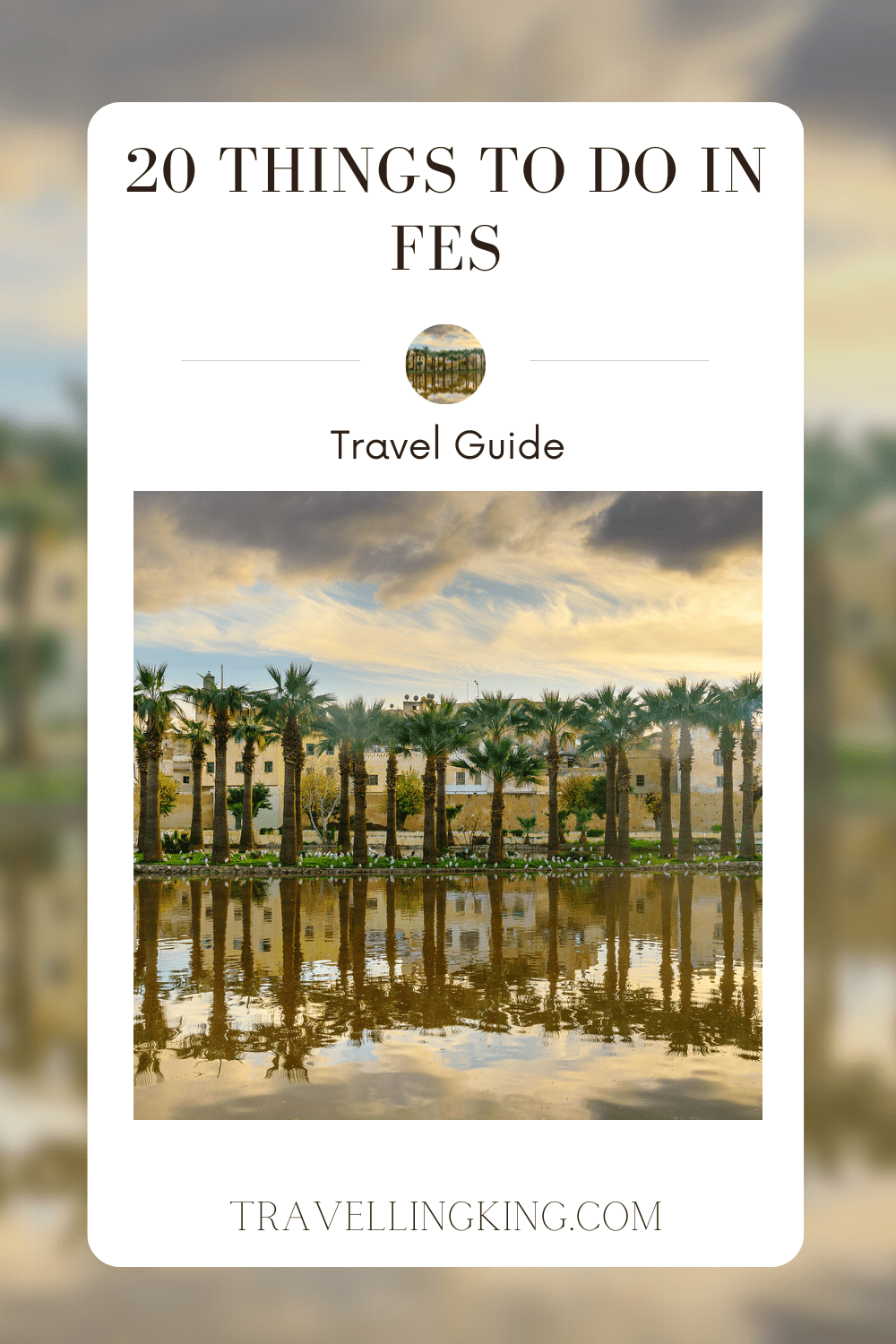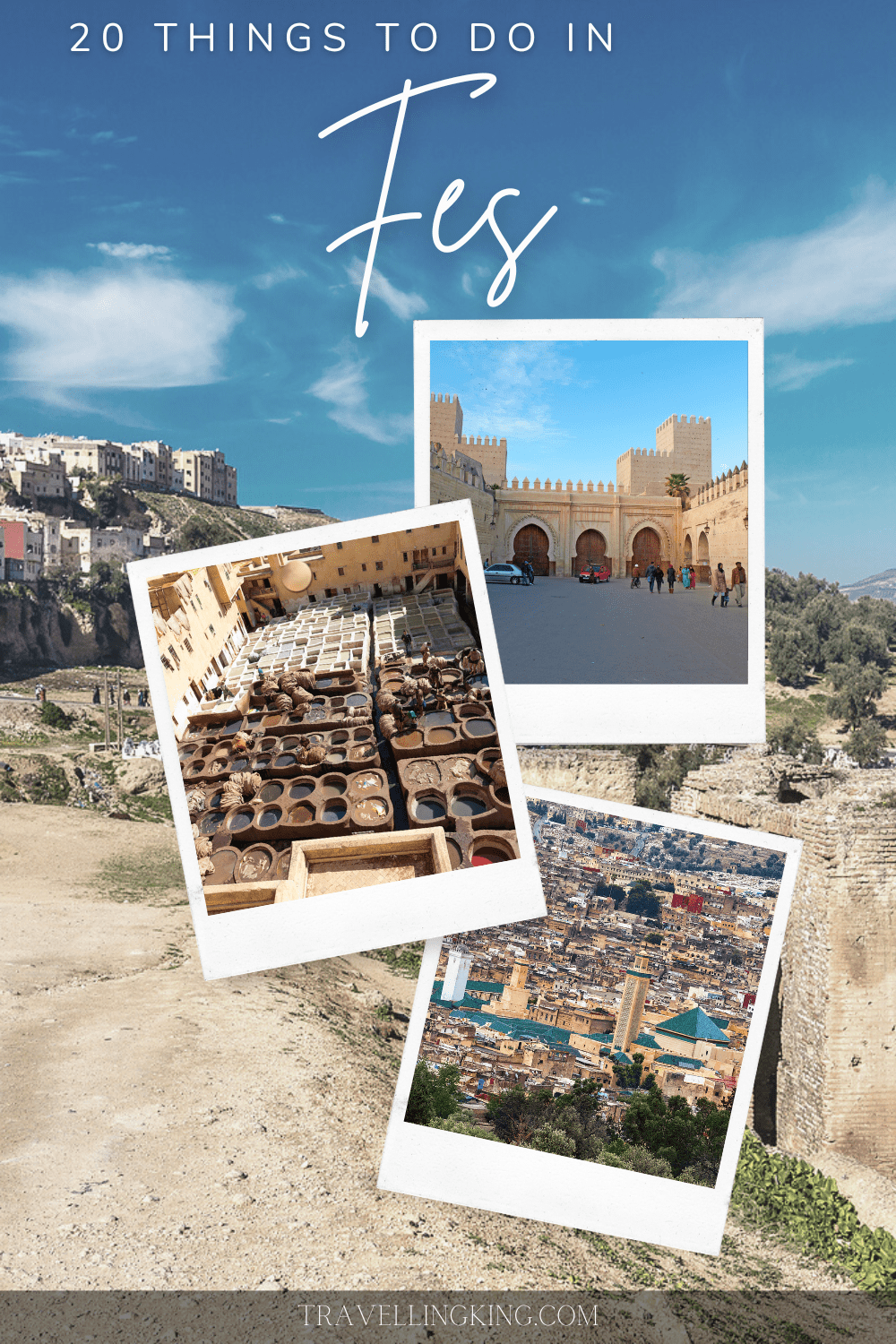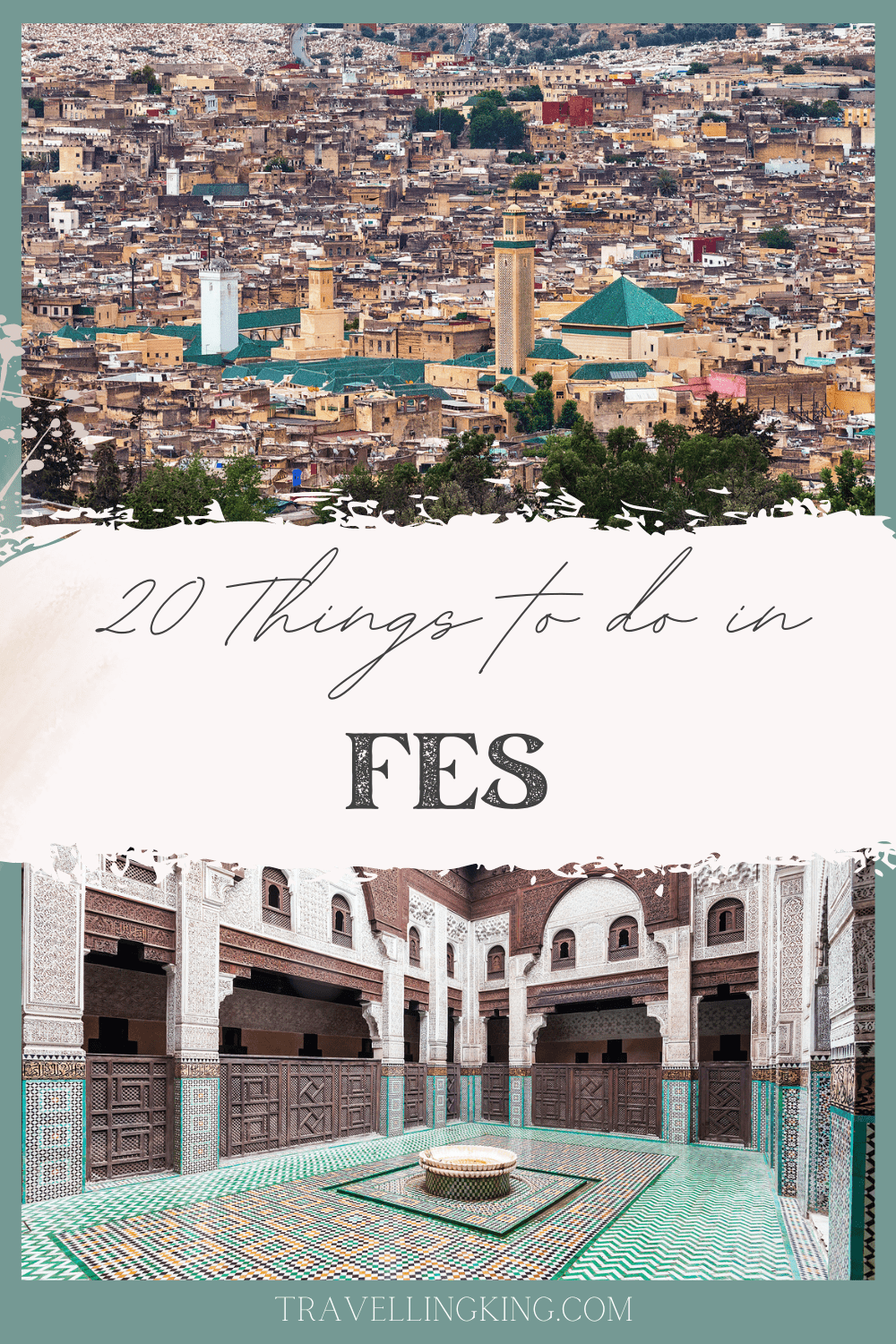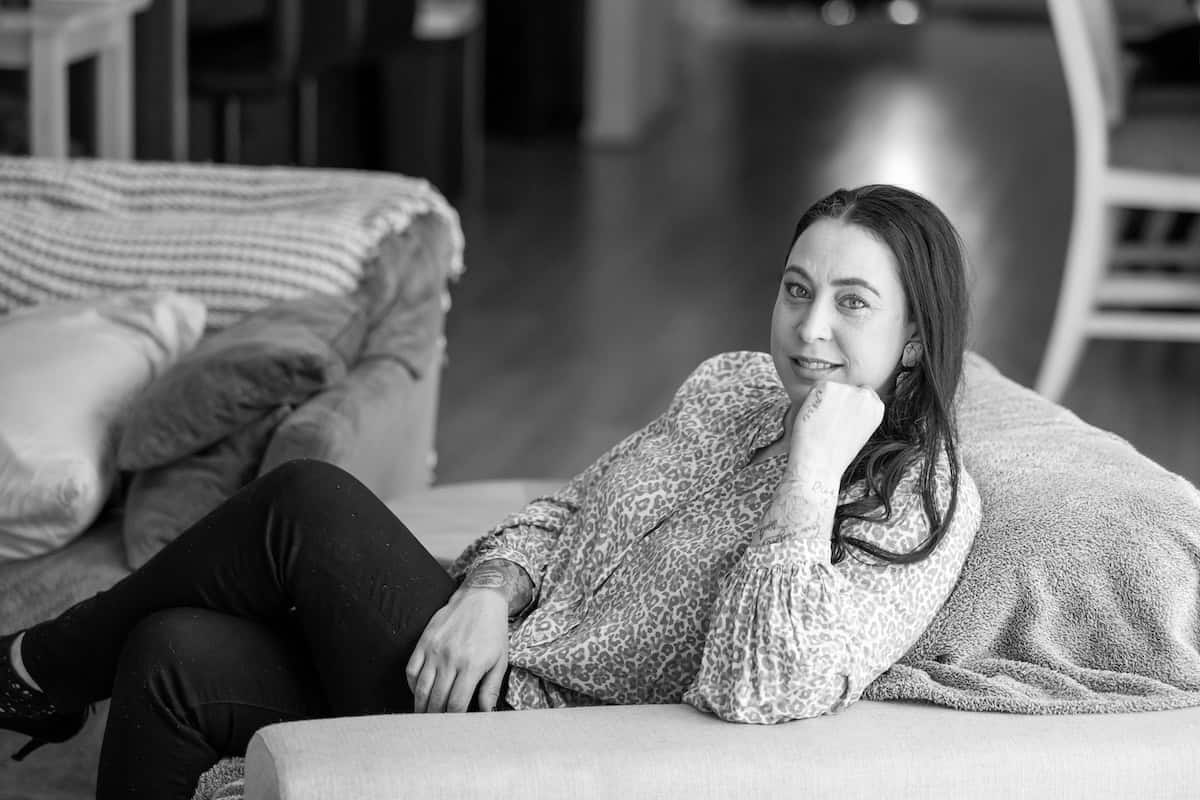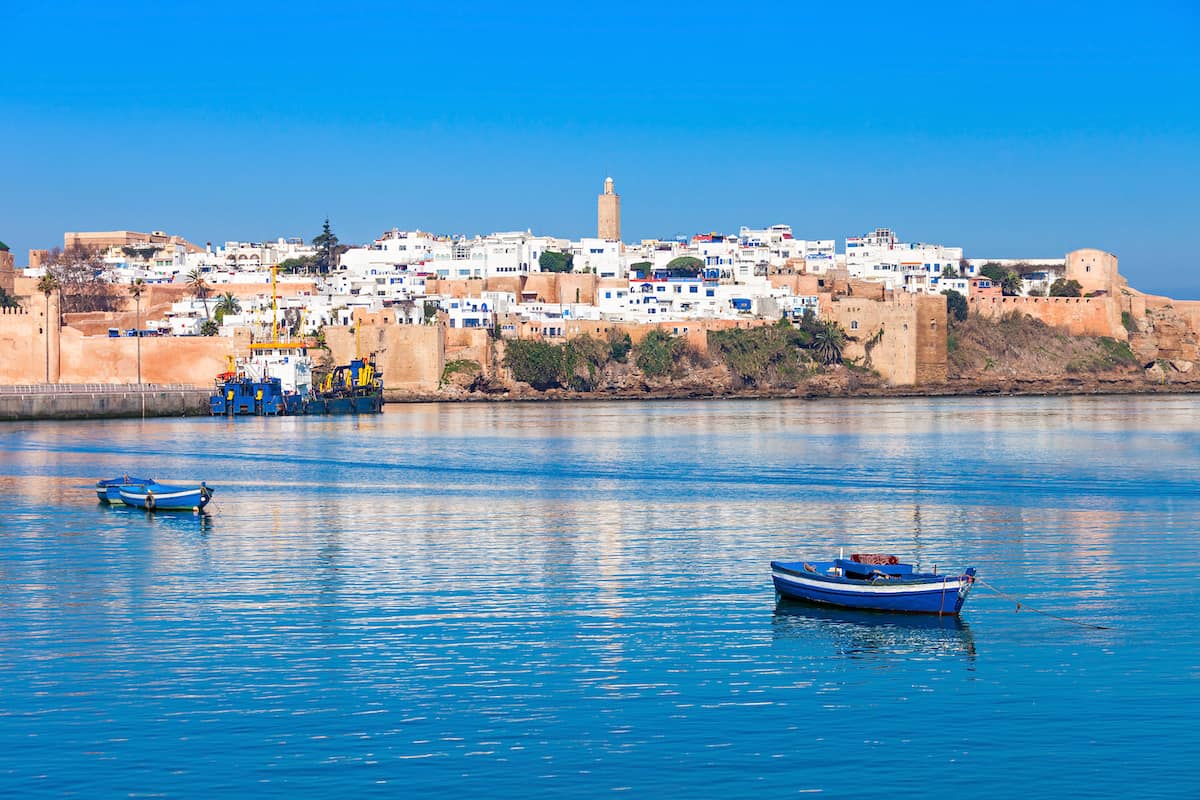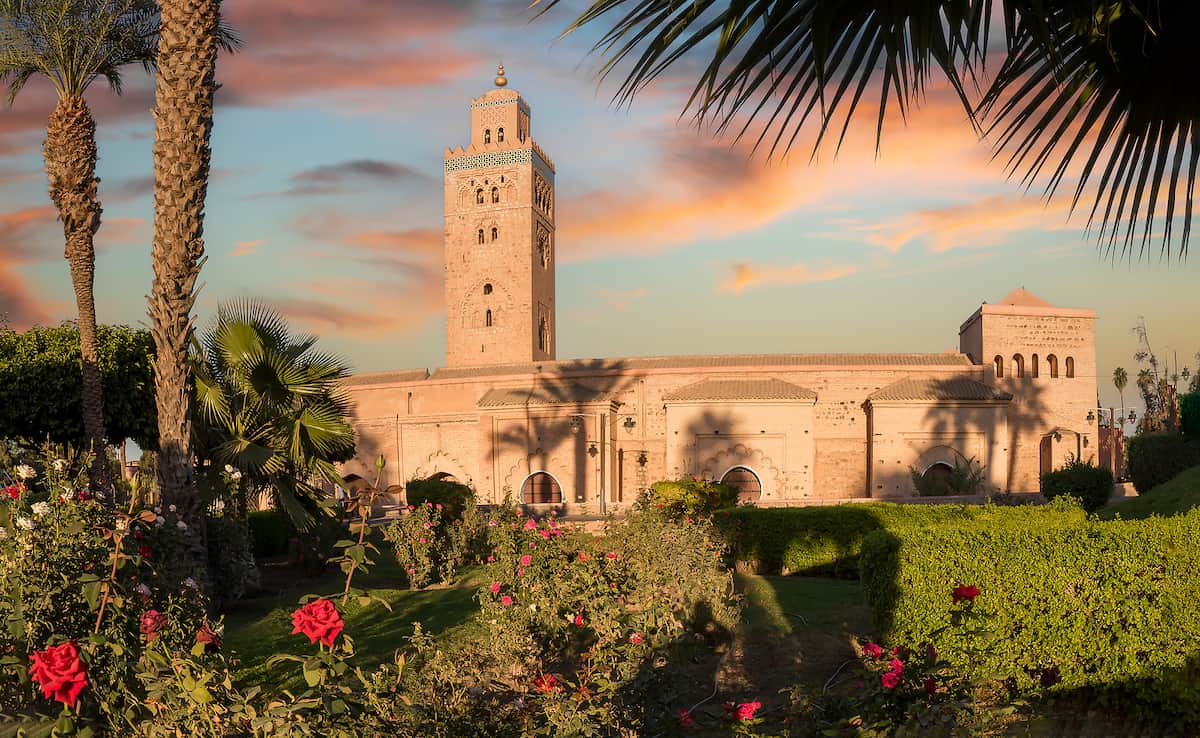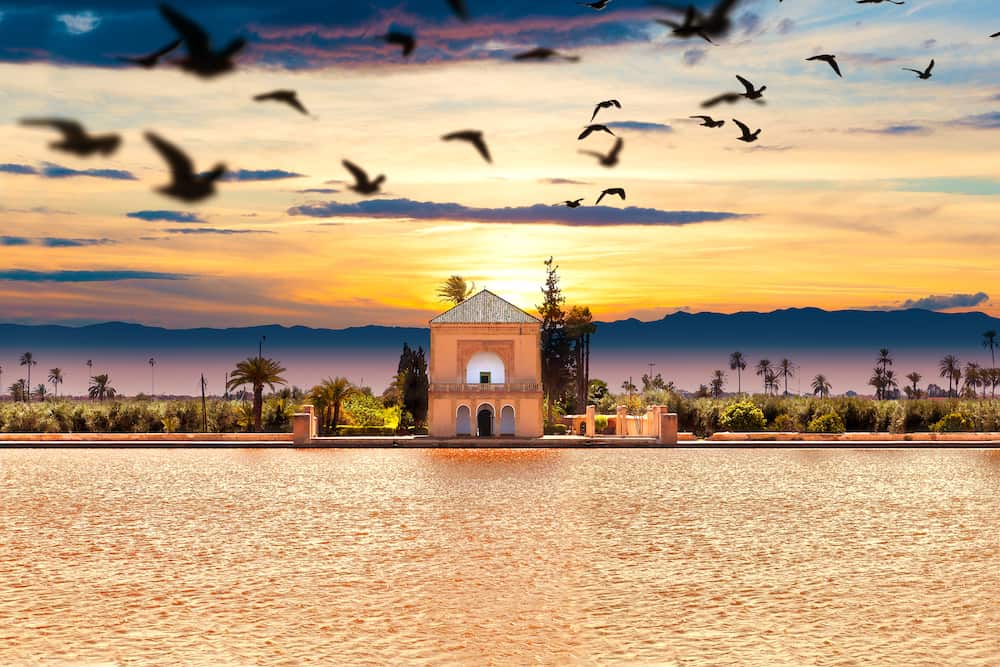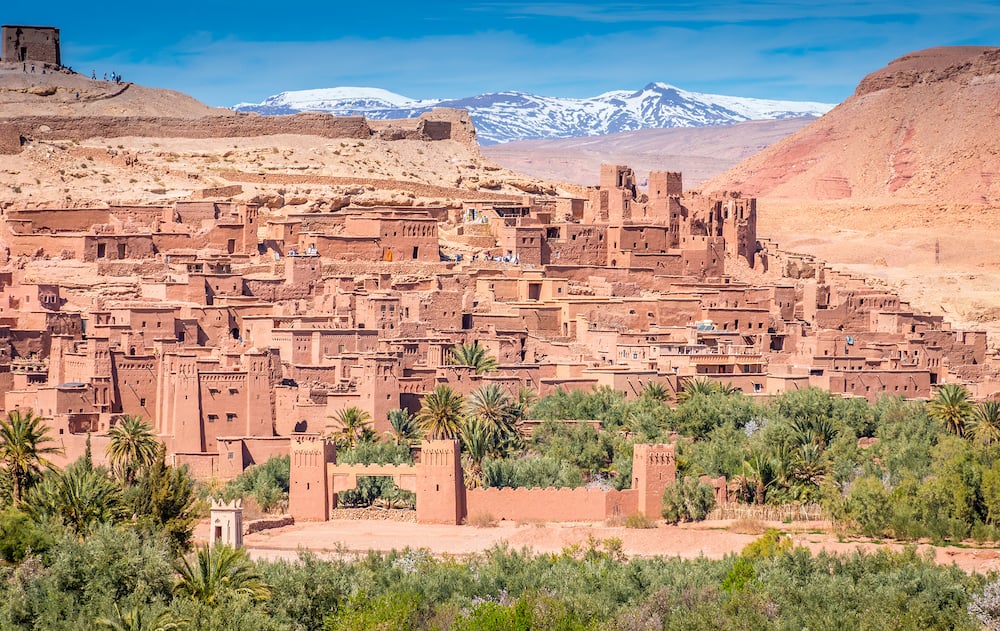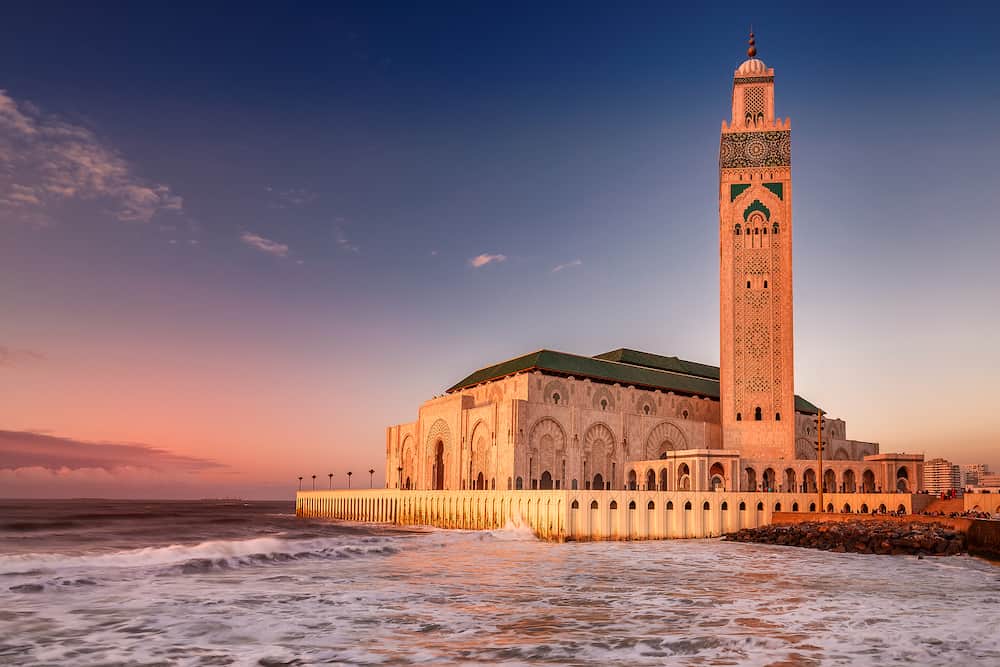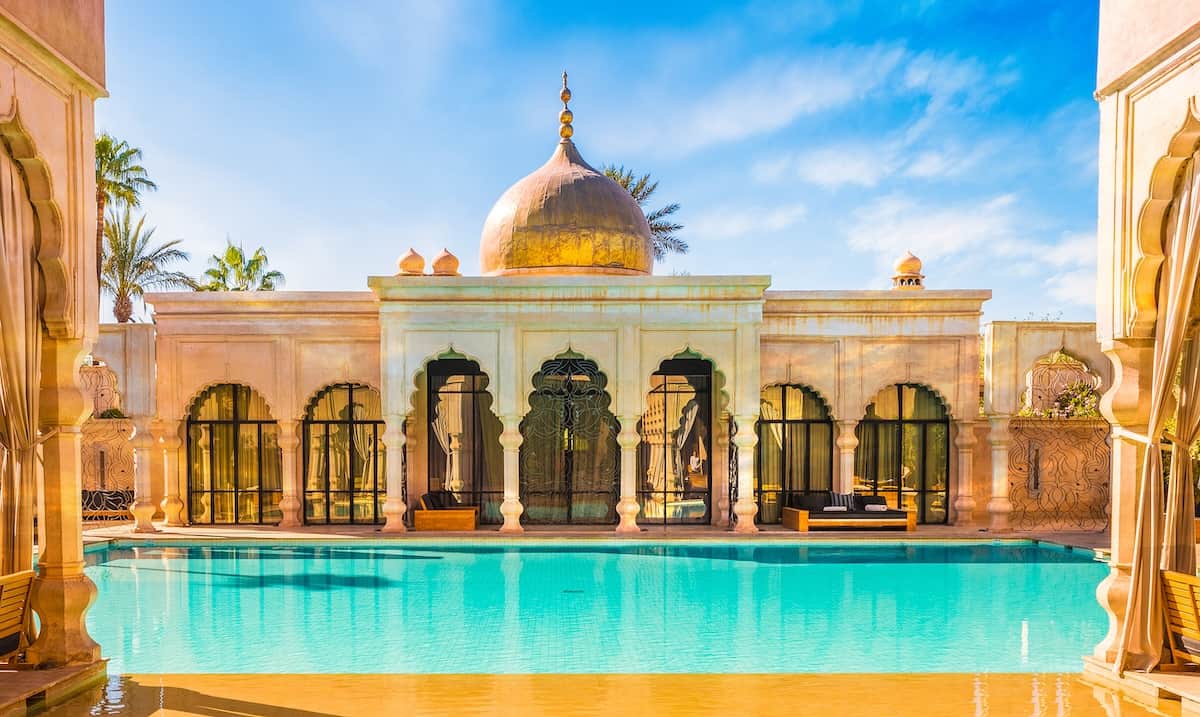20 Things to do in Fes
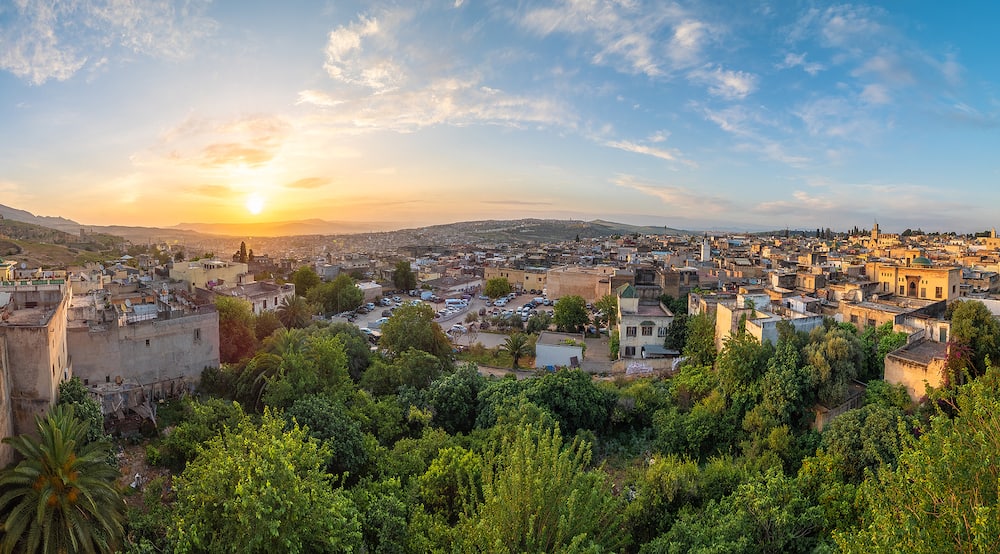
Fes (also written as Fez) is one of the four imperial cities of Morocco and is considered one of the country’s cultural and spiritual centres. It is a popular destination for its well-preserved mediaeval architecture and rich history, as well as its religious significance.
There are so many incredible things to do in Fes, as this city truly offers something for everyone, from history and culture to delicious food and relaxation. There’s always something new and exciting to discover in this vibrant and eclectic city.
To help you plan your trip of a lifetime to this Northern African gem, use this list as your Fes, Morocco travel guide. So, without further ado, here are 20 things to do and see in Fes.
Plan your trip
Save on fees abroad with the Wise Card—use it at ATMs, restaurants, and for flights or hotels in over 150 countries. Manage 40+ currencies in real-time with the Wise app.
Need Help Planning?
- Cheap Flights: Find the best deals.
- Accommodation: From hostels to luxury stays.
- Car Rental: Affordable options worldwide.
- Sightseeing Tours: Explore without breaking the bank.
- Travel Adapter: One adapter for all your needs.
- Travel Insurance: Don’t risk it—stay covered.
This post includes affiliate links. Read my full disclosure and content policy.
Fes el-Bali
Fes el-Bali is the city’s old walled medina, which offers a wonderful glimpse into the rich cultural and architectural heritage of Fes. Considered a UNESCO World Heritage Site, the old medina is one of the world’s largest urban car-free areas.
You can easily get lost in the colourful maze of narrow streets and alleys, which are lined with historic buildings and monuments everywhere you turn, so it’s worth getting a local tour guide.
Since there are no accurate maps, the exact amount of alleyways here is unknown, but some lifelong residents of Fes put the number at between 10,000 and 11,000!
More of the incredible places to visit in Fes listed below are located within Fes el-Bali.
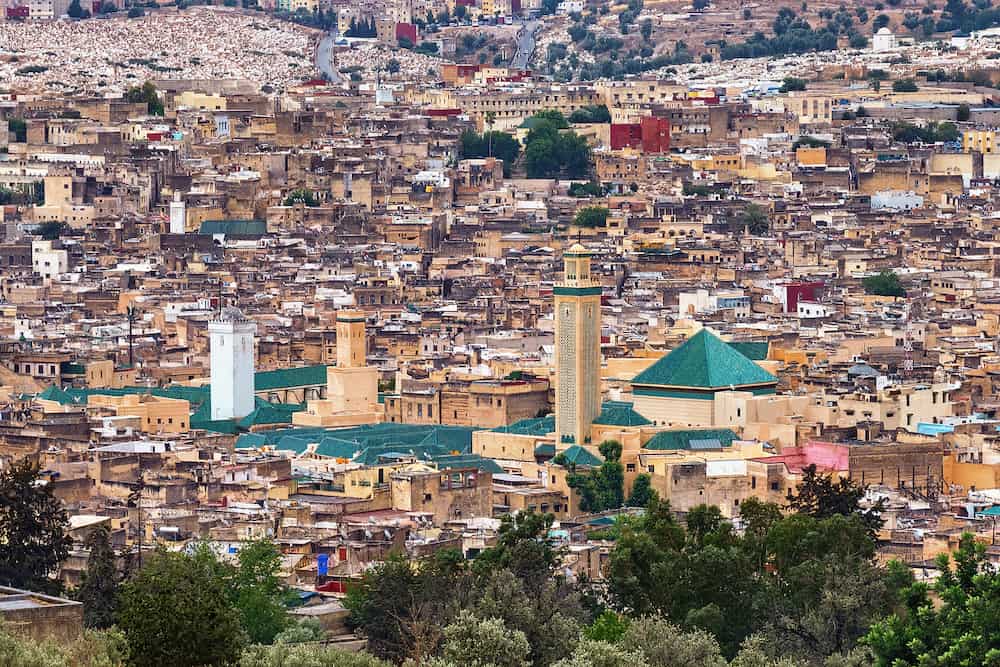
Bab Boujloud
The Bab Boujloud is one of the three main entrances into Fes el-Bali, yet it is actually a modern addition to the city. The large ornate archway was built in 1913 by the French colonial administration. It contains a geometric mosaic of cobalt blue tiles on the outside and green tiles on the inner side.
This Fez must-see attraction makes for an amazing photo op too. There are cafes and restaurants dotted around Bab Bou Jeloud, so you can sit and enjoy a cup of tea as you watch people coming and going through the beautiful archway.
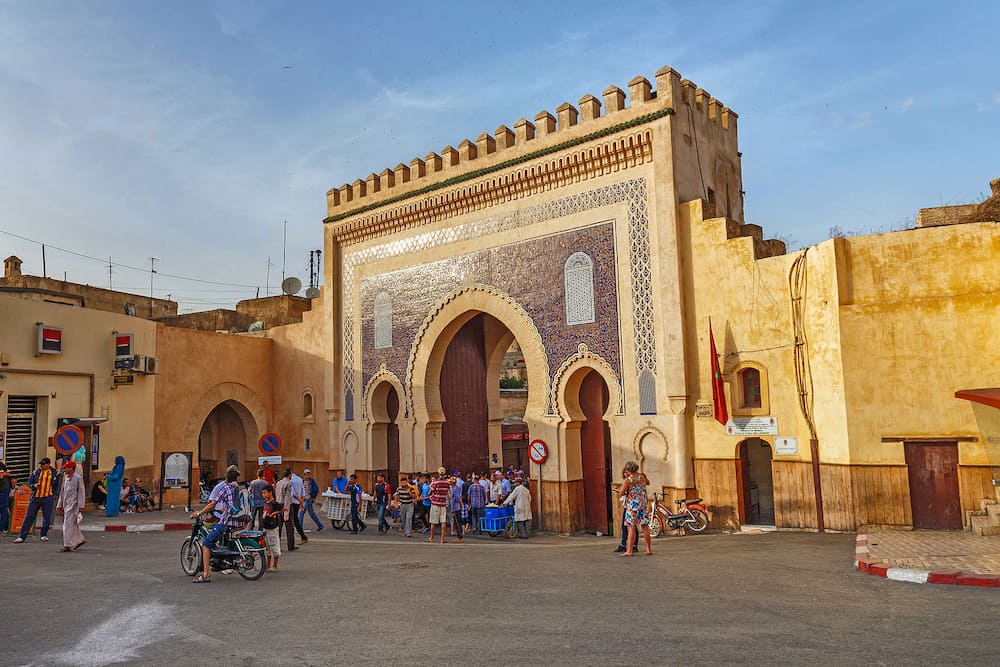
Bou Inania Madrasa
Bou Inania Madrasa is a historic religious school located in Fes, Morocco. Built in the mid-1300s during the reign of the Marinid dynasty, it is considered one of the best examples of architecture from this historical period.
The madrasa is known for its intricate tilework, stucco carvings and carved wooden doors, as well as its large central courtyard and tall minaret.
It was used as a religious school for over 600 years and is now open to the public as a museum. Although Bou Inania Madrasa is now used for different purposes, it remains a popular attraction in Fes.
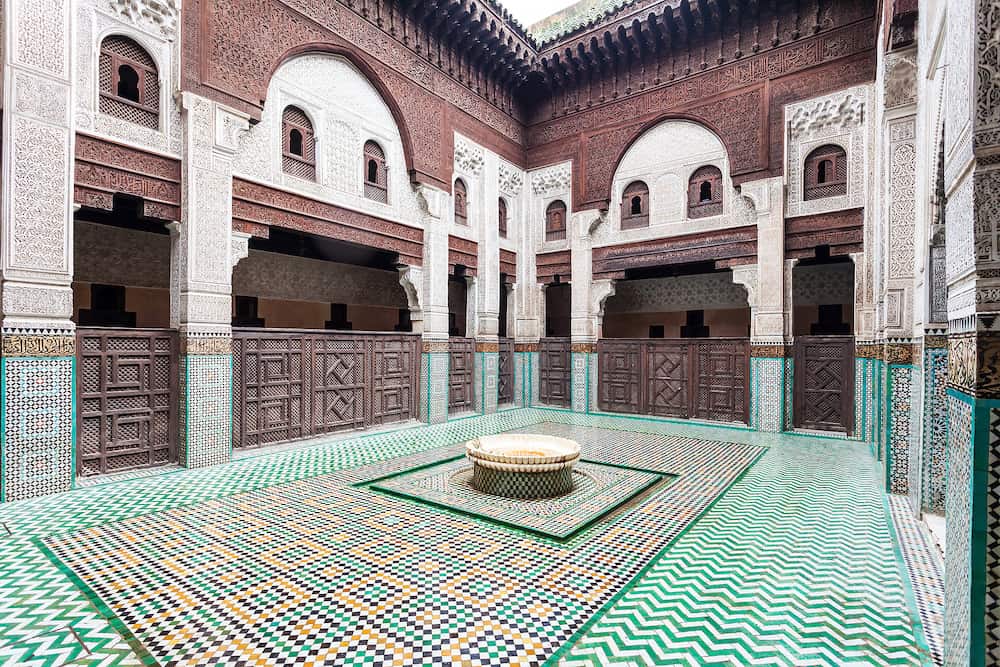
Al Quaraouiyine Mosque and University
The University of Al Quaraouiyine was originally founded as a mosque in the ninth century and emerged as a significant spiritual education centre during the Islamic Golden Age.
Architecturally, there are elements from several different periods in Moroccan history, reflecting the rich and enduring culture of Fes.
The Andalusian elements include the use of intricate geometric patterns, ornate calligraphy and the inclusion of traditional Spanish architecture like the carved wooden doors and horseshoe arches.
On the other hand, the Marinid elements include the brick and stone construction, as well as the elaborate decoration of the walls with stucco carvings and colourful tilework.
Although tourists aren’t able to enter, you should absolutely stop by to get a glimpse of the stunning exterior.
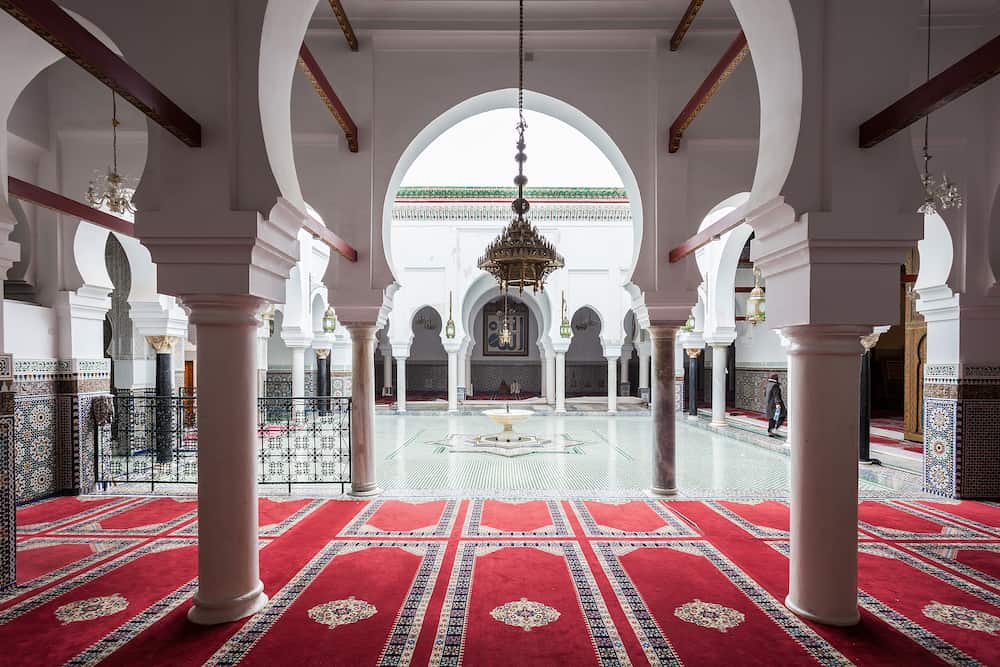
Dar Batha Museum
Dar Batha is a historic palace-turned-museum built in the late-1800s. This former royal palace is a wonderful example of Moroccan architecture, incorporating traditional elements like intricate tilework and carved wooden doors.
Dar Batha became a museum in 1915 and showcases over 6500 archaeological and historical artifacts. Among the collections are traditional Moroccan artworks, textiles, ceramics and other items of cultural significance.
Some of the oldest pieces come from the Idrisid era in the eighth and ninth centuries. A visit to the Dar Batha Museum is one of the best things to do in Fez if you want to learn about the rich history and culture of Fes.
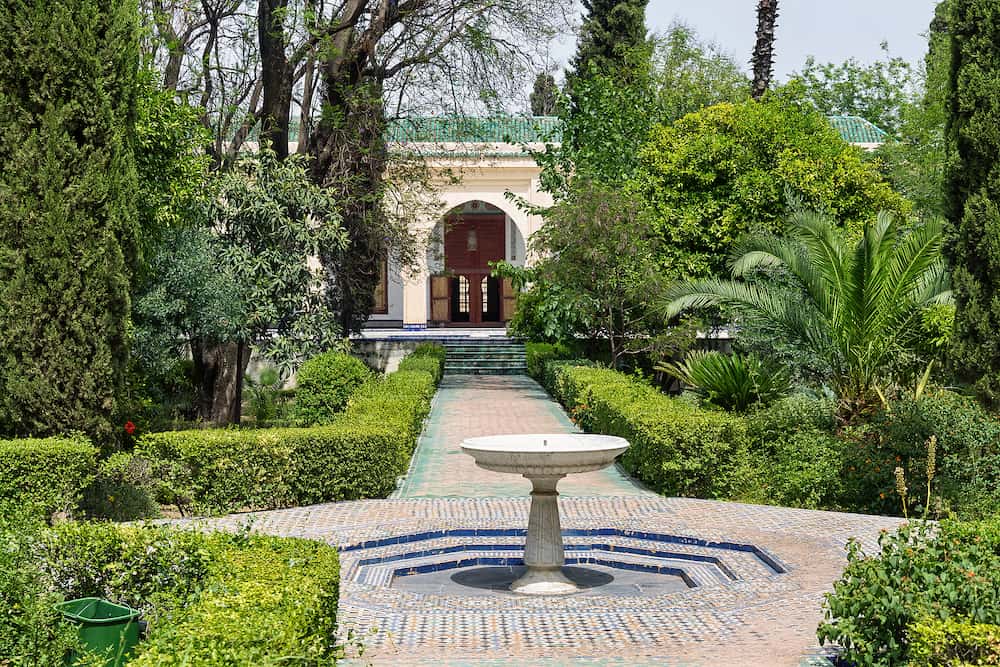
Dar al-Makhzen
Dar al-Makhzen is better known as the Royal Palace of Fez. Although the palace was rebuilt during the 17th century, its origins date back to 1276.
As it is currently in use by the King of Morocco and the government, tourists aren’t allowed inside.
You can, however, gaze at the dazzling bronze doors, admire the blue mosaic tiles adorning the walls, and take a peaceful walk through the surrounding gardens. From here, you can also spot the minaret of Fes el-Jdid.
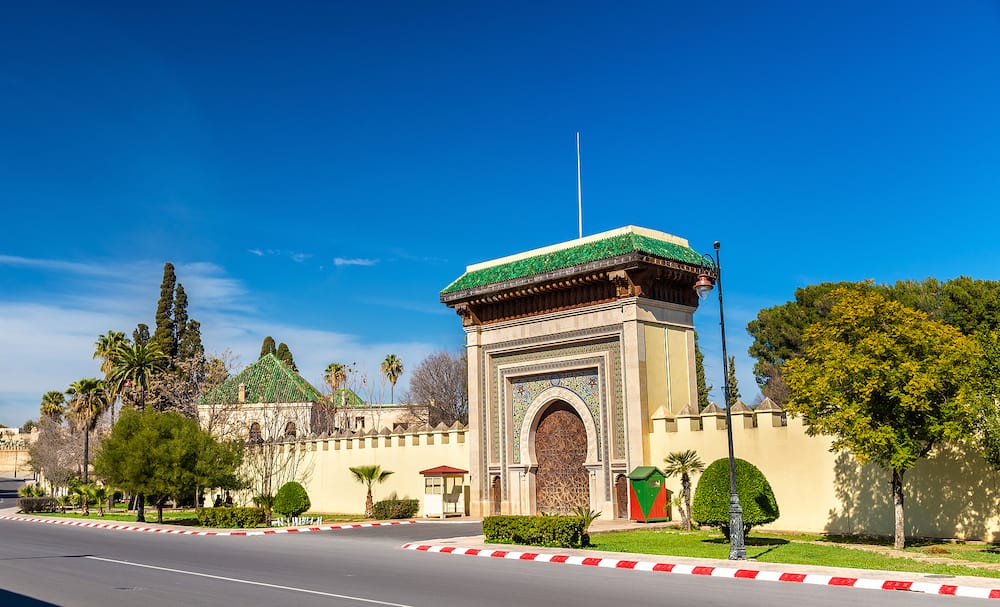
Al Attarine Madrasa
Al Attarine is another impressive madrasa in Fes, located close to the Al Quaraouiyine Mosque and University at the entrance of a spice and perfume market. Built in the 14th century, it is considered one of the finest examples of Marinid architecture.
The incredible rectangular courtyard is the highlight of Al Attarine Madrasa, with tall marble columns and delicately-carved wooden archways.
The walls feature immaculately carved stucco, Arabic calligraphy and elaborate mosaics of zellige tiles. This madrasa is easily one of the best places to visit in Fes if you’re seeking an unbelievable photo op!
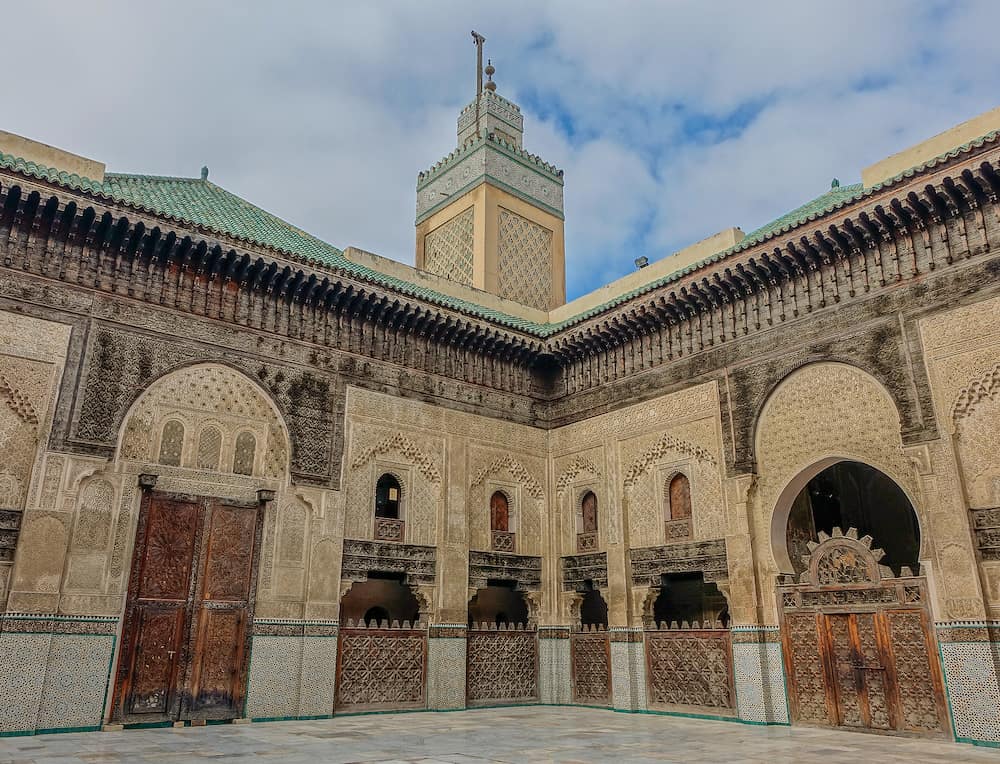
The Marinid Tombs
For an unforgettable panoramic view, head to the site of the Marinid Tombs. This 14th-century royal necropolis once loomed over the city of Fes.
Partial ruins of two mausoleums remain today, as well as a large horseshoe archway and parts of old walls. Although it remains a mystery as to who exactly was buried at this spot, it is assumed the pair were members of the royal family.
Nowadays, the top of the hill serves as a popular lookout spot and is a particularly magical place to watch the sun go down. However, as the site is quite remote, be careful not to stay long after dark, especially if you are there on your own.
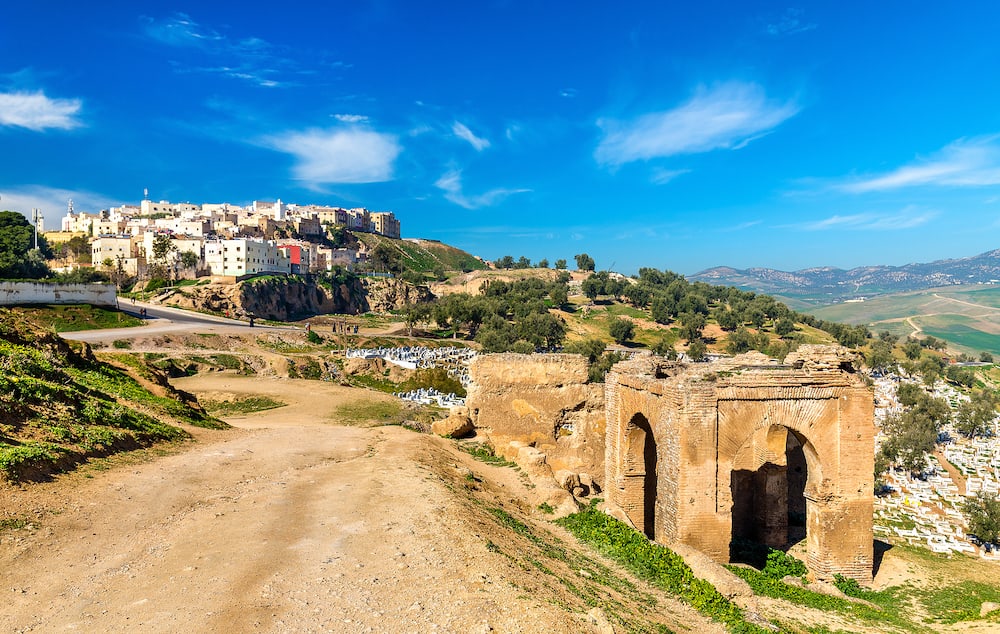
Zawiya of Moulay Idris II
One of the most sacred places in the city is the Zawiya of Moulay Idris II located in Fes el-Bali. This zawiya is an Islamic shrine which contains the tomb of Idris II, the founder of Morocco’s Idrisid dynasty. Idris II ruled Morocco in the early 800s and is considered to be the founder of Fes.
Taking a guided tour of the religious complex is highly recommended if you want to learn about Idris II and make sure you get to see the best elements and architectural highlights. The zawiya is made up of several buildings and courtyards, each with their own unique architectural features.
The mosque, located at the centre of the complex, is a simple yet elegant structure with a dome roof and a tall minaret. The walls are adorned with intricate tile work in traditional blue and green hues.
Towards the south end of the main courtyard is the astonishing mausoleum chamber containing the tomb of Moulay Idris II. The walls are lined with more intricate tile work and traditional Arabic calligraphy, creating a serene and spiritual atmosphere.
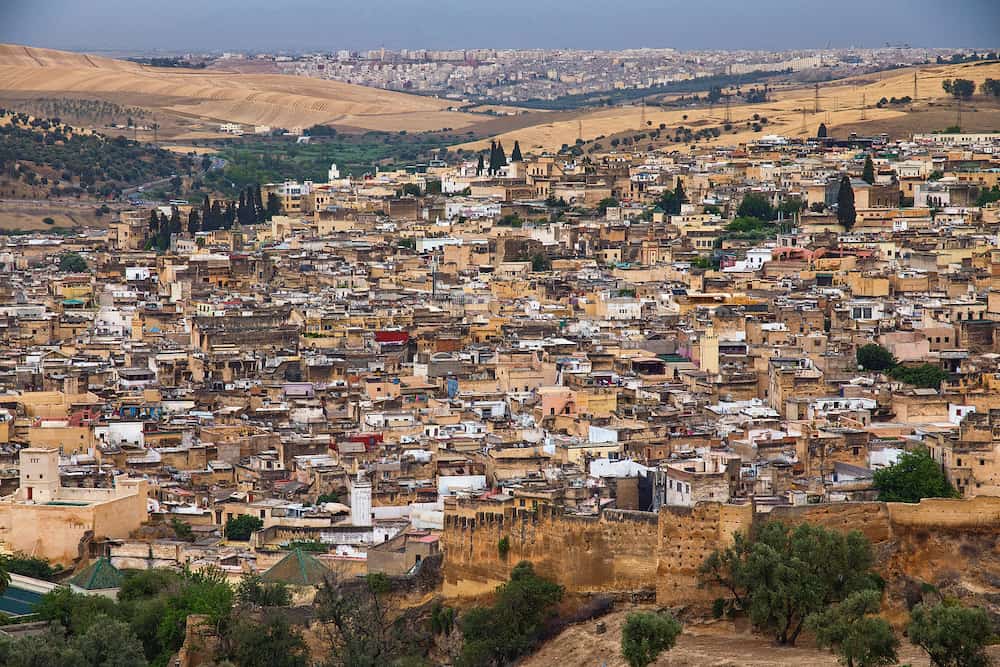
Nejjarine Museum of Wooden Arts and Crafts
The stunning Nejjarine Museum of Wooden Arts and Crafts is a former fondouk that has become an exhibition of traditional Moroccan wooden artworks.
Look up from the ground floor of the central courtyard and you will see rows of beautifully-carved wooden balconies and pillars with incredible stucco detailing. The unique lattice screens (called mashrabiya) and granary doors have been created in impressive detail.
Among the artifacts on display are musical instruments, ancient dowry chests and prayer beads. Unlike many attractions that only offer descriptions in Arabic and French, this museum, fortunately, provides them in English too.
Not only that, but there’s also a quaint little rooftop cafe here where you can have a cup of tea and take in the view of the city.
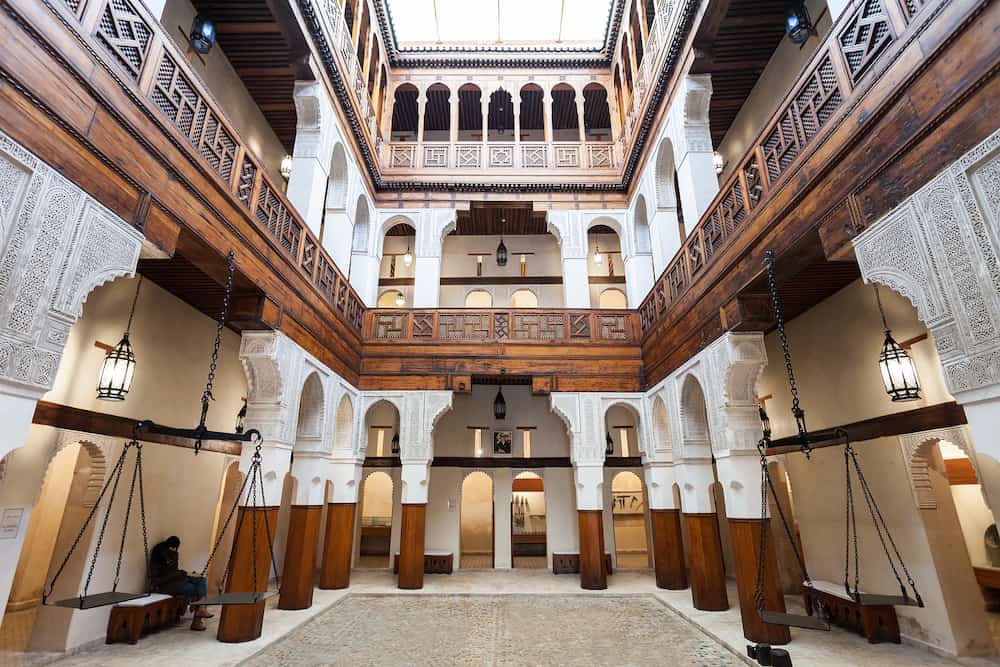
Moroccan Hammam
One thing you absolutely must experience in Morocco is a hammam. While you may already be familiar with hammams if you’ve ever been to Turkey, Morocco does their steam baths a little differently. As well as being bathed, exfoliated and massaged, you’ll also get a cup of Moroccan mint tea.
Not only is this an age-old tradition practised by all social classes, but it’s also the perfect way to unwind after a busy day of walking through the medina.
While many amazing hammams are located within hotels, such as Le Spa du Palais Faraj and Spa Laaroussa, the Hammam Mernissi & Spa is found within the medina, making the experience even more authentic.
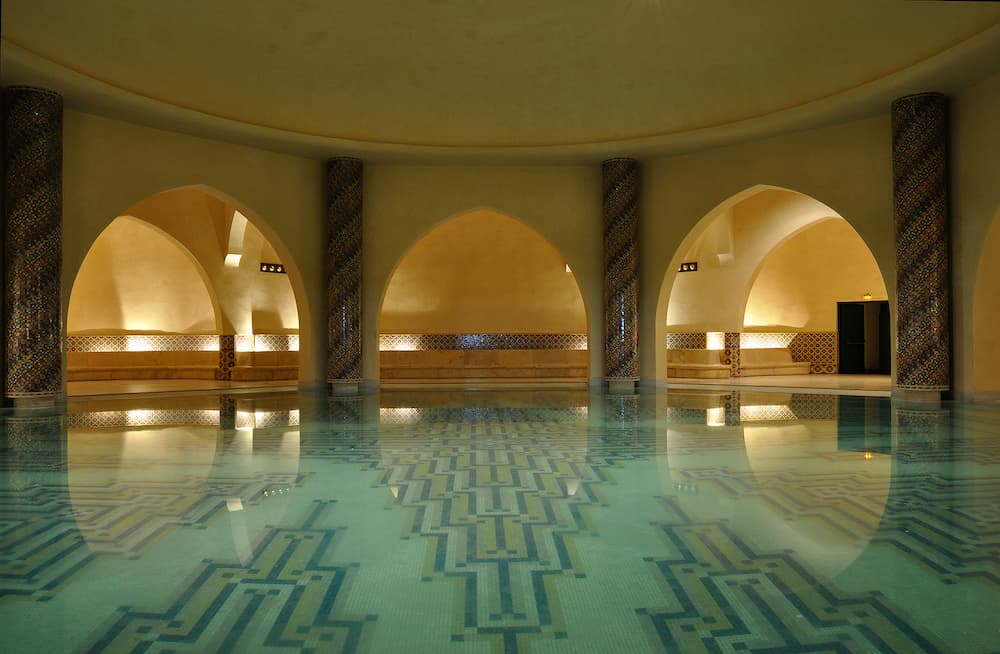
The Jewish Quarter
Although Fes no longer has a significant Jewish population, a historic Jewish quarter of the city remains in Fes el-Jdid. The Mellah, as the area is known, dates back to the 16th century, when the city’s Jewish residents were segregated from the majority Muslim population.
Walking around, you will immediately notice that houses here are notably different to those of the rest of the city. While traditional Moroccan homes feature interior courtyards, many houses in the Mellah have street-facing balconies decorated with sculpted motifs.
One of the most notable buildings within the Jewish quarter is the Ibn Danan Synagogue. Built in the mid-17th century, the synagogue features green and white herringbone tiles and numerous shining chandeliers.
Another significant area of the Mellah is the large Jewish cemetery with all-white semi-cylindrical tombs.
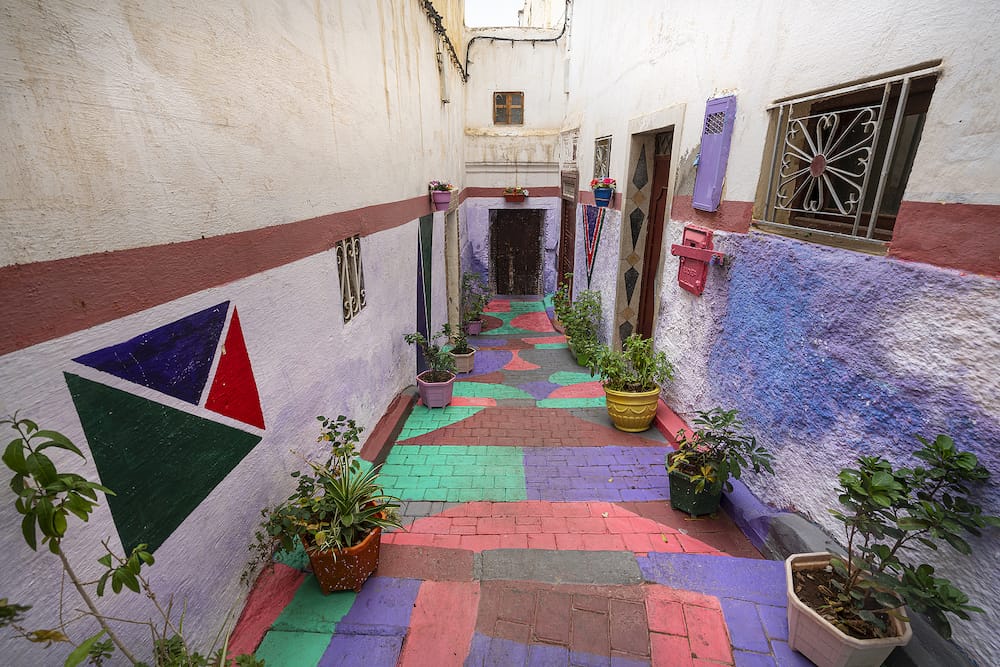
Moroccan Cooking Class
What better way is there to discover the local cuisine than by learning to cook it yourself? One of the most fun things to do in Fes, Morocco is to take a cooking class.
Whether you opt for a class at the Fez Cooking School at Palais Amani or learn from local women in their own family home, learning to cook authentic Moroccan dishes like chicken tagine, couscous, harira and taktouka will easily be one of the highlights of your trip.
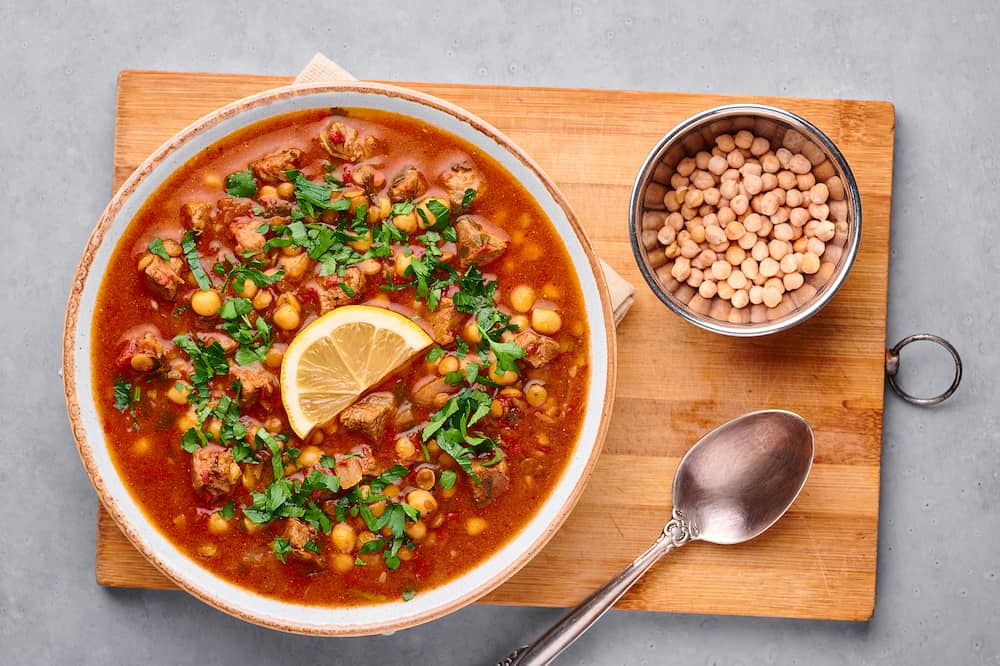
Borj Nord
On the outskirts of Fes is Borj Nord, a historical fortification built by the Saadi dynasty in 1582. Strategically located on a hill overlooking the city, it was modelled after 16th-century Portuguese forts and was one of the largest defensive structures in the region.
Since 1963, the fortress has housed the Museum of Arms, the first of its kind in Morocco. The museum’s collection holds 5,000 pieces of arms and armour, ranging from the prehistoric era up until the 20th century.
Although there are artifacts from numerous countries on display, there is also an emphasis on weaponry made and used in Morocco. The best example of this is the five-metre-long Saadian cannon from the 1578 Battle of Three Kings.
While Borj Nord is an excellent place to learn about the history of Morocco, it also happens to provide amazing views of the city and the surrounding countryside.
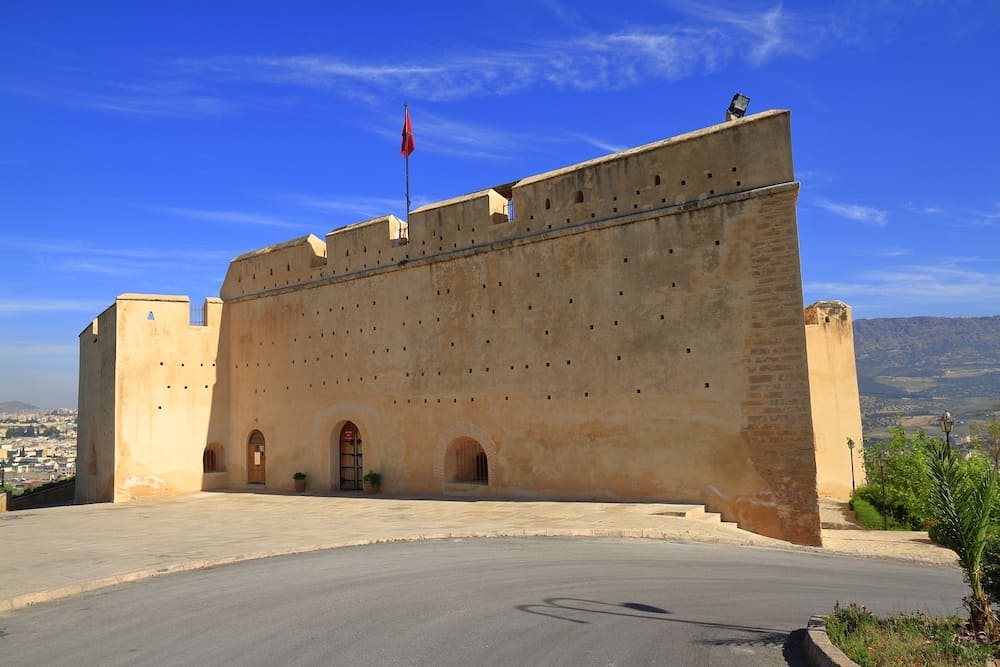
Bab Makina Plaza
Bab Makina Plaza is one of the city’s most popular ancient plazas. The stunning stone square is surrounded by high stone walls and towers, instantly transporting you back into mediaeval times.
One of the most unforgettable things to do in Fes at night is to visit this plaza when music festivals are held and the square is bustling with people. The Fes Festival of World Sacred Music is the most well-known musical event put on here, occurring annually during the middle of summer.
Artists of all faiths and religions come together to celebrate and showcase spiritual music from all corners of the world. The impressive light shows projected onto the stone walls of Bab Makina during the performances take the experience to a whole new level.
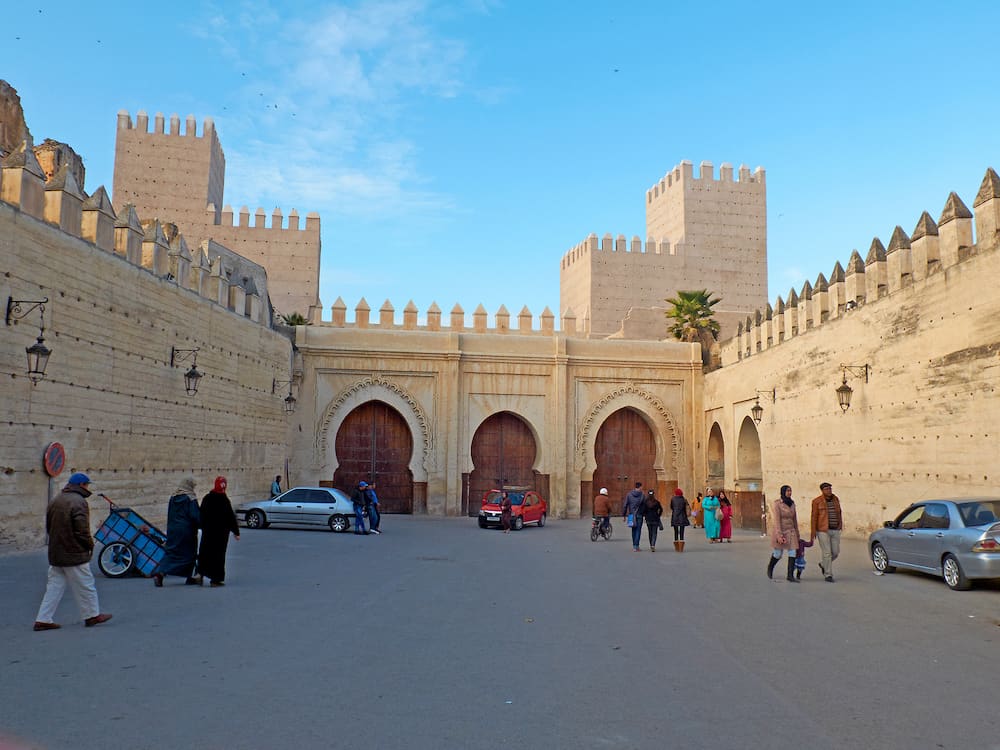
Chouara Tannery
Fes is known for its traditional tanning industry, which dates back to medieval times. While there are three main tanneries in Fes, the largest and most well-known is the Chouara Tannery, where the age-old techniques of leather tanning are still practised today.
Visitors can see the many stone vats filled with all sorts of natural coloured dyes and liquids that are involved in the process, with the animal hides drying in the hot sun.
This industry not only provides employment to many local families and helps to maintain the city’s cultural heritage, but also proves to be a popular tourist attraction.
Despite the invention of modern tanning methods, workshops in Fes still use traditional techniques to ensure high-quality leather products that can be sold either internationally or to other local craftsmen.
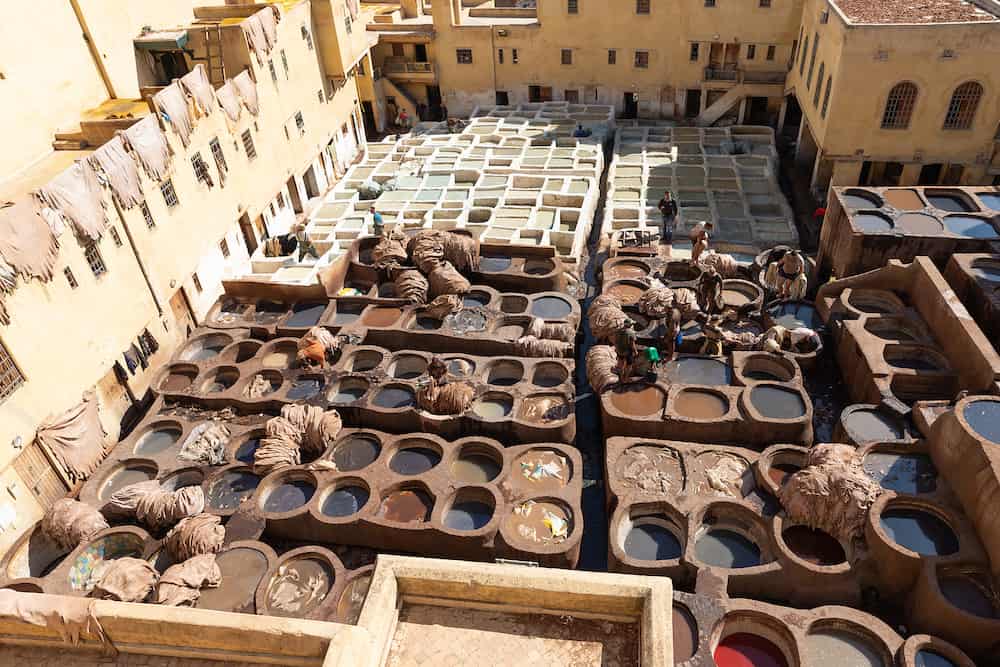
Seffarine Square
One of the most lively spots in the medina is Seffarine Square, a popular gathering place for locals and tourists alike. The square is named after the Seffarine neighbourhood, which is known for its traditional copper workshops.
You can see artisans at work here creating and selling copper products like lanterns, trays and teapots. Even if you’re not interested in purchasing anything, it’s a great area to walk through and take a look at.
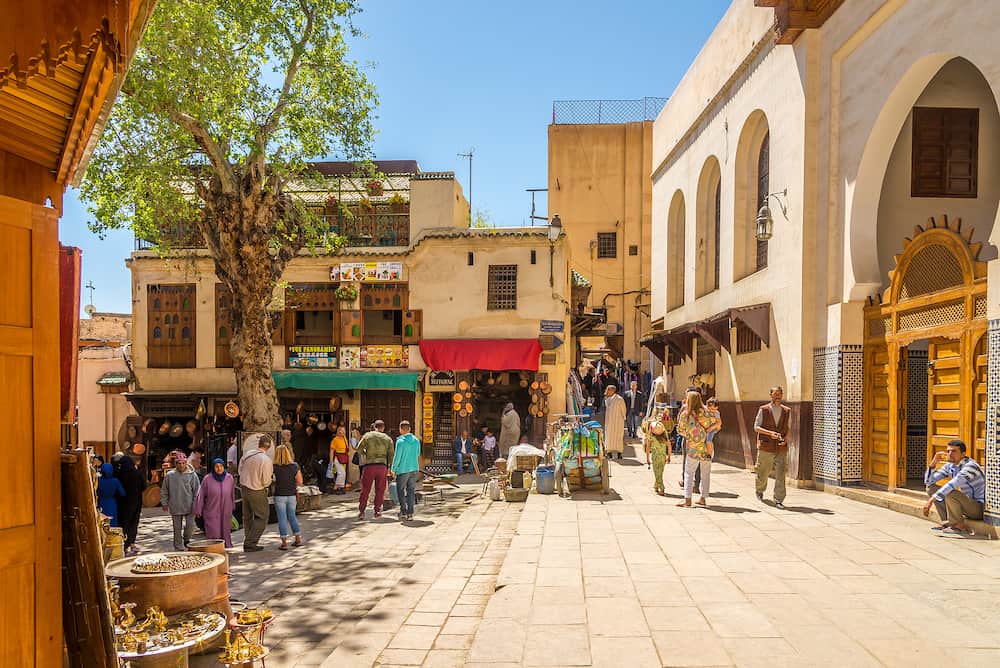
Jardin Jnan Sbil
Need a little breath of fresh air away from the hustle and bustle of the city? One of the most serene and picturesque public spaces in all of Fes is Jardin Jnan Sbil, also known as the Bou Jeloud Gardens.
Between Fes el-Bali and Fes el-Jdid sits seven-and-a-half hectares of meticulously manicured space with over 3,000 different plant species. Wander the grounds and explore the array of round and star-shaped fountains, or just sit and bird-watch for a while.
This garden is one of only a few open green spaces in the city and is often enjoyed by the locals at dusk. However, be aware that the gardens are closed on Mondays.
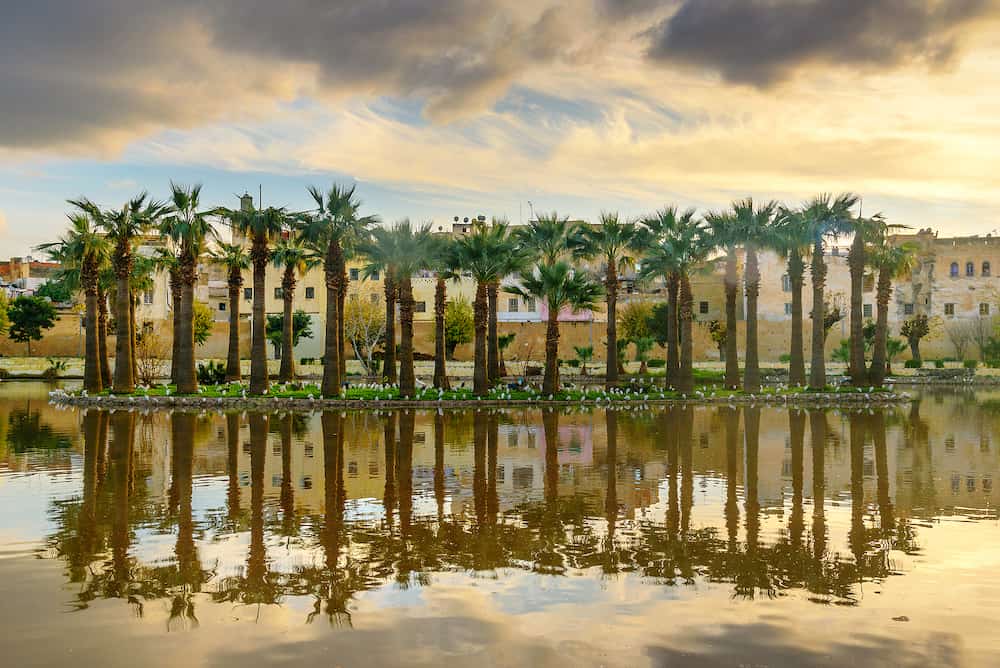
Volubilis
If you have the time to take a day trip outside of Fes, don’t miss out on visiting the nearby Roman ruins of Volubilis.
This once-thriving city was an important trade and commerce hub during the Roman occupation in the first century, though it was originally developed in the third century BC as a Berber settlement.
Although the city was abandoned for centuries, looted by Moroccan rulers, and later partially destroyed by an earthquake in the 18th century, excavations in the 1900s have uncovered many fine mosaics and Neolithic pottery.
As it is now listed as a UNESCO World Heritage Site, many of the prominent buildings and houses have been able to be restored and reconstructed.
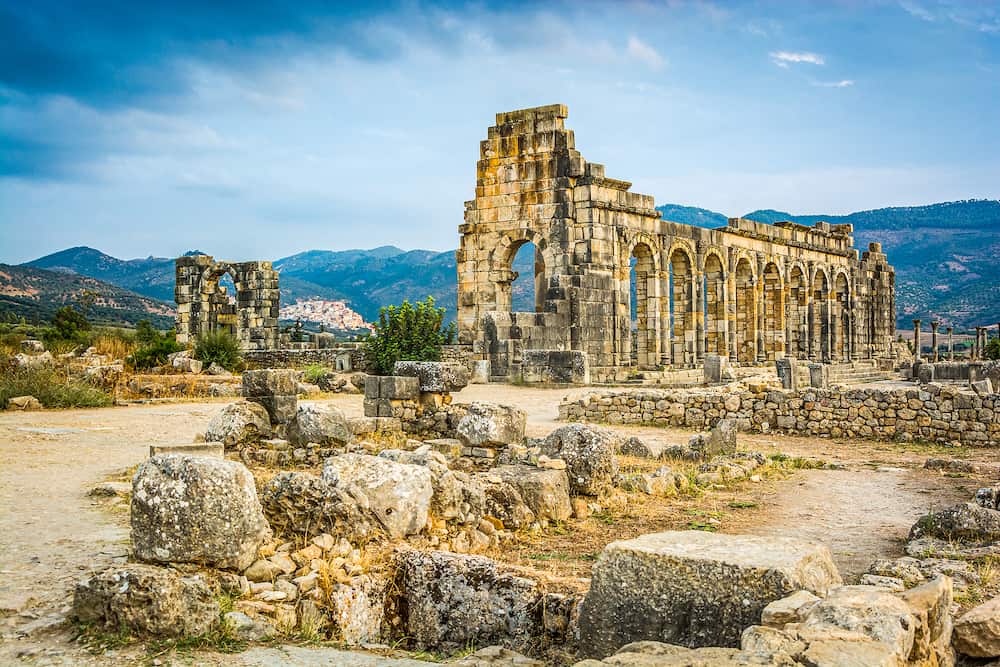
Moulay Yacoub
If you feel like really pampering yourself, head to the spa town of Moulay Yacoub. Located 21 kilometres northwest of Fes, the region is known for its natural hot springs and public baths using water pumped from the ground below.
Moulay Yacoub is considered a sacred place for many Moroccans, historically used as a place for healing rituals. You can easily spend a couple of hours here soaking in the warm, therapeutic waters that are believed to aid in healing many aches and pains of the body.
Recommended tours in Fes
- Luxury 2-Days Desert Trip from Fes to.:( fes or marakech)
- Medina Guided Tour
- Fez Medina 4-Hour Guided Walking Tour
- 3 day desert tour from Fes to Marrakech
- Full-day Historical Meknes Volubilis and Moulay Idriss Tour
- Unforgettable Cooking Class in Fez
- Day Trip to Chefchaouen the blue city
- Overnight Luxury Desert Tour from Fez with Camel Ride
- Small-Group Full-Day Meknes, Volubilis and Moulay Idriss Zerhoun Tour from Fez
- Fez Cooking School at Palais Amani Experience
- A Unique Experience In Fes With A Guide And A Driver (Full Day)
If you’d like to save it for later, please save it to Pinterest.
